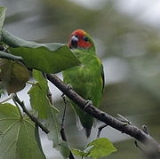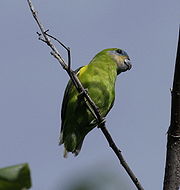
Double-eyed Fig Parrot
Encyclopedia
The Double-eyed Fig Parrot Cyclopsitta diophthalma, also known as the Blue-faced Fig Parrot, Red-faced Fig Parrot, Dwarf Fig Parrot, and the Two-eyed Fig Parrot, primarily inhabits forests on New Guinea
and nearby islands, but is also found in isolated communities along the tropical Australia
n coast, east of the Great Dividing Range
. With an average total length of about 14 cm (5½ in.), it is the smallest parrot in Australia.
Most subspecies
of the Double-eyed Fig Parrot are sexually dimorphic, with males having more red (less silvery and blue) to the face than the females. It is predominantly green with a very short tail, a disproportionately large head and bill, and red and blue facial markings. Its name is derived from the cheek patches of some subspecies that vaguely resemble eyes.
Although assessed as of Least Concern
by the IUCN, certain subspecies are under threat. Coxen's Fig Parrot (C. d. coxeni) is of one Australia's rarest and least known birds, having been recorded on fewer than 200 occasions since being described by Gould
in 1866. It is classified as Endangered in Queensland
(Nature Conservation Act 1992
), New South Wales
(New South Wales Threatened Species Conservation Act 1995), and also nationally in Australia (Environment Protection and Biodiversity Conservation Act 1999
) as it has declined due, at least in part, to the clearing of lowland subtropical rainforest over its range.
s, berries
, seed
s, nectar, and the grubs of wood-boring insects. This foraging is done in pairs or in a flock of only a few individuals. It tends to fly in a quick and direct manner. It produces a short and shrill call. Unlike many other parrots which generally use existing holes in trees for nests, Double-eyed Fig Parrots excavate their own nest cavities, usually in a rotten tree.
Double-eyed Fig Parrots utter high-pitched, clipped, two or three note zzzt-zzzt or zeet-zeet calls, unlike the rolling or trilling screeches typical of lorikeets. These calls are mostly made in flight, but sometimes when perched. When engrossed in feeding, it may also make a variety of softer, chattering noises.

_-cairns-8.jpg) There are eight described subspecies of the Double-eyed Fig Parrot. The first five are restricted to New Guinea and associated islands; the last three are restricted to Australia.
There are eight described subspecies of the Double-eyed Fig Parrot. The first five are restricted to New Guinea and associated islands; the last three are restricted to Australia.
New Guinea
New Guinea is the world's second largest island, after Greenland, covering a land area of 786,000 km2. Located in the southwest Pacific Ocean, it lies geographically to the east of the Malay Archipelago, with which it is sometimes included as part of a greater Indo-Australian Archipelago...
and nearby islands, but is also found in isolated communities along the tropical Australia
Australia
Australia , officially the Commonwealth of Australia, is a country in the Southern Hemisphere comprising the mainland of the Australian continent, the island of Tasmania, and numerous smaller islands in the Indian and Pacific Oceans. It is the world's sixth-largest country by total area...
n coast, east of the Great Dividing Range
Great Dividing Range
The Great Dividing Range, or the Eastern Highlands, is Australia's most substantial mountain range and the third longest in the world. The range stretches more than 3,500 km from Dauan Island off the northeastern tip of Queensland, running the entire length of the eastern coastline through...
. With an average total length of about 14 cm (5½ in.), it is the smallest parrot in Australia.
Most subspecies
Subspecies
Subspecies in biological classification, is either a taxonomic rank subordinate to species, ora taxonomic unit in that rank . A subspecies cannot be recognized in isolation: a species will either be recognized as having no subspecies at all or two or more, never just one...
of the Double-eyed Fig Parrot are sexually dimorphic, with males having more red (less silvery and blue) to the face than the females. It is predominantly green with a very short tail, a disproportionately large head and bill, and red and blue facial markings. Its name is derived from the cheek patches of some subspecies that vaguely resemble eyes.
Although assessed as of Least Concern
Least Concern
Least Concern is an IUCN category assigned to extant taxon or lower taxa which have been evaluated but do not qualify for any other category. As such they do not qualify as threatened, Near Threatened, or Conservation Dependent...
by the IUCN, certain subspecies are under threat. Coxen's Fig Parrot (C. d. coxeni) is of one Australia's rarest and least known birds, having been recorded on fewer than 200 occasions since being described by Gould
John Gould
John Gould was an English ornithologist and bird artist. The Gould League in Australia was named after him. His identification of the birds now nicknamed "Darwin's finches" played a role in the inception of Darwin's theory of evolution by natural selection...
in 1866. It is classified as Endangered in Queensland
Queensland
Queensland is a state of Australia, occupying the north-eastern section of the mainland continent. It is bordered by the Northern Territory, South Australia and New South Wales to the west, south-west and south respectively. To the east, Queensland is bordered by the Coral Sea and Pacific Ocean...
(Nature Conservation Act 1992
Nature Conservation Act 1992
The Nature Conservation Act 1992 is an act of the Parliament of Queensland that provides for the legislative protection of Queensland's threatened biota. As originally published, it provided for biota to be declared presumed extinct, endangered, vulnerable, rare or common...
), New South Wales
New South Wales
New South Wales is a state of :Australia, located in the east of the country. It is bordered by Queensland, Victoria and South Australia to the north, south and west respectively. To the east, the state is bordered by the Tasman Sea, which forms part of the Pacific Ocean. New South Wales...
(New South Wales Threatened Species Conservation Act 1995), and also nationally in Australia (Environment Protection and Biodiversity Conservation Act 1999
Environment Protection and Biodiversity Conservation Act 1999
The Environment Protection and Biodiversity Conservation Act 1999 is an Act of the Parliament of Australia that provides a framework for protection of the Australian environment, including its biodiversity and its natural and culturally significant places...
) as it has declined due, at least in part, to the clearing of lowland subtropical rainforest over its range.
Behaviour
The Double-eyed Fig Parrot generally forages for figFicus
Ficus is a genus of about 850 species of woody trees, shrubs, vines, epiphytes, and hemiepiphyte in the family Moraceae. Collectively known as fig trees or figs, they are native throughout the tropics with a few species extending into the semi-warm temperate zone. The Common Fig Ficus is a genus of...
s, berries
Berry
The botanical definition of a berry is a fleshy fruit produced from a single ovary. Grapes are an example. The berry is the most common type of fleshy fruit in which the entire ovary wall ripens into an edible pericarp. They may have one or more carpels with a thin covering and fleshy interiors....
, seed
Seed
A seed is a small embryonic plant enclosed in a covering called the seed coat, usually with some stored food. It is the product of the ripened ovule of gymnosperm and angiosperm plants which occurs after fertilization and some growth within the mother plant...
s, nectar, and the grubs of wood-boring insects. This foraging is done in pairs or in a flock of only a few individuals. It tends to fly in a quick and direct manner. It produces a short and shrill call. Unlike many other parrots which generally use existing holes in trees for nests, Double-eyed Fig Parrots excavate their own nest cavities, usually in a rotten tree.
Double-eyed Fig Parrots utter high-pitched, clipped, two or three note zzzt-zzzt or zeet-zeet calls, unlike the rolling or trilling screeches typical of lorikeets. These calls are mostly made in flight, but sometimes when perched. When engrossed in feeding, it may also make a variety of softer, chattering noises.
Subspecies

_-cairns-8.jpg)
- Cyclopsitta diophthalma diophthalma
- Cyclopsitta diophthalma coccineifrons
- Cyclopsitta diophthalma aruensis
- Cyclopsitta diophthalma virago
- Cyclopsitta diophthalma inseparabilis
- Cyclopsitta diophthalma marshalli (Marshall's Fig Parrot)
- Cyclopsitta diophthalma macleayana (Macleay's Fig Parrot or Red-browed Fig Parrot)
- Cyclopsitta diophthalma coxeni (Coxen's Fig Parrot)
External links
- World Parrot Trust Parrot Encyclopedia - Species Profiles

